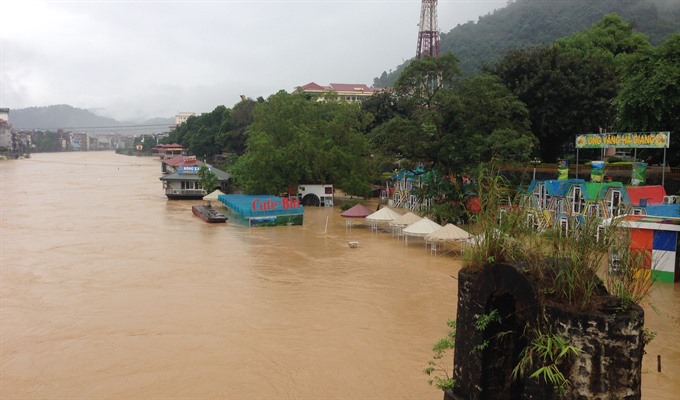 Environment
Environment

Climate change is damaging production and livestock in the country’s northeast provinces, raising the risks that the poverty rate there could increase in the next few years, according to a new study by scientists of the Việt Nam Academy of Social Sciences.
 |
| Up to 30 flashfloods reportedly occurred in Con River and Chảy River in Hà Giang Province between 2004 and 2010.— Photo hagiang.gov.vn |
HÀ NỘI — Climate change is damaging production and livestock in the country’s northeast provinces, raising the risks that the poverty rate there could increase in the next few years, according to a new study by scientists of the Việt Nam Academy of Social Sciences.
The study showed that climate change has been causing extreme weather phenomena, including thunderstorms, torrential rain, hail, prolonged heat waves and cold weather, flashfloods and landslides in the provinces for years.
For example, extreme cold weather, with temperatures falling as low as 0 degrees, has hit
Up to 30 flashfloods reportedly occurred in
Due to the extreme weather phenomena, production activities were badly affected. It is estimated that over 9,000ha of crop have been damaged each year since 2011. The damage is up to billions of đồng, the study found.
Therefore, local farmers should change the types of trees they grow to better adapt to climate change. They have started to grow cardamom, anise, pear and tangerine in
Scientists also pointed out that climate change contributed to outbreaks of disease among animals and poultry. Increasing temperatures, along with the degree of large temperature fluctuations, have caused more animals to experience heat shock.
Data from the Department of Animal Health under the Ministry of Agriculture and Rural Development said foot-and-mouth disease was believed to appear with higher frequency during 2006-15 than in previous years. In 2008 alone, over 54,000 cows and buffaloes were reportedly killed by foot-and-mouth disease in the provinces due to prolonged cold weather.
The impacts of climate change also threaten the cause of poverty reduction in the northern provinces.
The north is a unique mountainous region dominated by rivers. Extreme floods and other natural disasters in the area have caused economic losses each year at an estimated rate of 1-1.5 per cent of GDP, scientists said.
According to local administrators, severe shortages of fresh water often occur in the four districts of Quản Bạ, Yên Minh, Đồng Văn and Mèo Vạc in the dry season.
The various natural disasters have reduced the standard of living for people in the northeast provinces. The local residents have to spend money in stabilising production damaged by natural disasters. The expenses available for medical and educational services are thus also reduced, the study found.
How to solve
Nguyễn Song Tùng, vice president of the Institute of Human Geography under the Việt Nam Academy of Social Sciences, said authorised agencies should help local farmers to apply new models of production to better adapt to climate change, such as the System of Rice Intensification (SRI) model.
SRI is an agro-ecological methodology for increasing the productivity of irrigated rice by changing the management of plants, soil, water and nutrients.
Local farmers were also advised to apply bio-pads in husbandry in general and pig-raising in particular, as well as to raise fish in cages in rivers and lakes to gain more income, Tùng said.
People should grow trees that bring higher economic value, he added.
Staff from the local agriculture agency was told to instruct people to fertilise their trees with nitrogenous fertiliser and manure to reduce greenhouse gas emissions, he added.
Local administration was asked to study and implement measures to ensure water security for people who have suffered the most from severe shortages of fresh water in the coming time, he said.
If all the methods were efficiently applied, the threat of poverty increasing would also be under control, he said.
The northeast region includes the nine provinces of Lạng Sơn, Cao Bằng, Bắc Kạn, Thái Nguyên, Tuyên Quang, Phú Thọ, Bắc Giang and Quảng Ninh, with the total area accounting for 15.3 per cent of the country’s area and the population comprising 9.35 per cent of the country’s total. — VNS